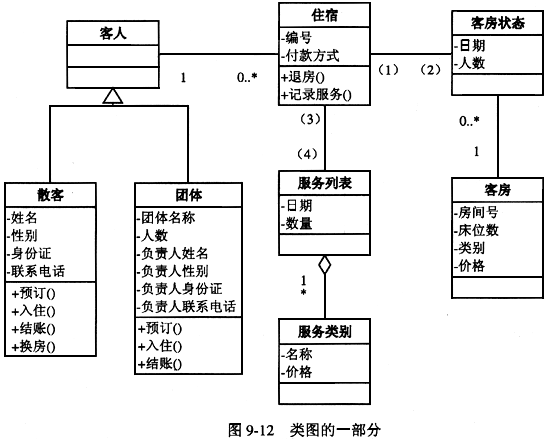阅读下列说明和图,回答问题1至问题3。
【说明】
某大型旅店为了便于管理,欲开发一个客房管理系统。希望实现客房预订、入住登记、账务结算、退房,以及将服务项目记入客人账单。
旅客包括散客和团体,散客预订或入住时需要提供姓名、性别、身份证和联系电话,团体则提供团体名称、负责人的姓名、性别、身份证和联系电话,以及团体人数。对于散客,还要提供换房。
旅店还提供了很多服务项目,比如早餐。对每一个入住客人,服务列表记录了住宿期间的各项服务,包括服务类型、日期、数量等。当然,客人也可以不要任何服务。
旅店的客房有一个唯一的房间号,分为不同的类别,不同的房间床位数和价格不同。
为了有效的管理,需要记录每天的客房状态。客房的状态有:空闲、占用、已预订和维修。
· 客人入住后,客房处于占用状态。
· 客人退房后,客房处于空闲状态。
· 客人预订后,客房处于已预订状态。
· 预订客人入住后,客房处于占用状态。
· 预订客人取消预订后客房处于空闲状态。
· 需要维修时客房处于维修状态。
· 维修完成后客房处于空闲状态。
该系统采用面向对象方法开发,系统中的类及类之间的关系用UML类图表示,如图9-12所示是该系统的类图的一部分,图9-13描述了客房状态的转变情况。


| 【问题2】 在UML中,重复度(Multiplicity)定义了某个类的一个实例可以与另一个类的多少个实例相关联。通常把它写成一个表示取值范围的表达式或者一个具体的值。例如图9-12中的类客人和住宿,客人端的“1”表示:一个住宿类的实例只能与一个客人类的实例相关联;住宿类端的“0..*”表示:一个住宿类的实例可以与0个或多个客人类的实例相关。请指出图9-12中(1)到(4)处的重复度分别为多少 |
参考答案:
解析:0..1 (2) 1..* (3) 1 (4) 0..*
[分析]: 散客入住时只改变一个客房状态,而团体入住时则有可能改变多个客房状态;客房状态改变不一定是住宿导致的,客房维修同样改变客房状态。因此(1)处应填0..1,(2)处应填1..*。 客人可以有多项服务,但只需用一张“服务列表”,当然也可能不需要任何服务;而一张服务列表必然属于而且只输于一个住宿。因此(3)处应填1,(4)处应填0..1。
